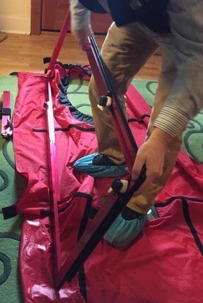A calibrated blower door, invented in the early 1970’s, is a machine that measures the air tightness of your home. This assists your Josh Lowe’s Dr. Energy Saver Energy Consultant in locating where the air leakage is occurring so he can determine what is making your home uncomfortable.
This powerful fan mounts into the frame of an exterior door. Only the fabric is touching the door frame. The fan will pull air out of your home. With a lower air pressure inside, the higher air pressure outside wants to come into your home through the cracks! It is exaggerating the air leaks, helping your Energy Consultant and you find out where the leaks and drafts are coming from and thereby the energy losses you are experiencing from this leakage. The pressure measurement instrument—the manometer—measures this pressure difference.
If you have a fireplace or wood-burning stove, the fire will need to be completely out at least 36 hours prior to the test. Ashes can be sucked into your home, and it is quite a mess! Any open fireplaces need to be completely cleaned out for the same reason. The dampers and any other woodstove air inlets will need to be closed.
The fan starts up slowly to depressurize your home. The fan is then turned up until the pressure reaches around 50 Pascals (simulating a 15 MPH wind on all sides of your home). Walk around the home with your Energy Consultant and have him use the infrared thermal imaging camera and the puff air current detector to see where air is entering your home. Most homes have leaks in areas other than windows, such as cracks between your floor and baseboards, recessed can lights, kitchen soffits (where wiring and piping above cabinets are usually located), and fireplaces. If you can put your hand near these spots, you can feel air rushing in!
Your Energy Consultant will then read the airflow, measured in cubic feet per minute (CFM). A cubic foot of air is about the size of a basketball. He then inputs the result into a spreadsheet along with information about your home (e.g., square footage, # of bedrooms, height of ceiling) and the resulting number shows how leaky your home is. He or she will then work with you to create a prioritized list of solutions to solve these issues and help make your home more comfortable and energy efficient.

